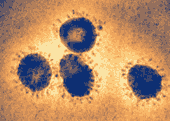Severe Acute Respiratory Syndrome (SARS)
NOTE: This page is archived for historical purposes and is no longer being maintained or updated.

Severe acute respiratory syndrome (SARS) is a viral respiratory illness. It was first identified in China in late 2002 and was reported in Asia in February 2003. Over the next few months SARS spread to more than two dozen countries in North America, South America, Europe, and Asia before it was contained. Although there have been very few cases of occupationally acquired SARS in the United States, NIOSH recognizes the potential for spread of the disease within the workplace, especially for workers who experience daily contact with the general public, such as health care, medical transport, and airline personnel, as well as those who deal directly with potentially SARS infected material, such as laboratorians. The following topic page is designed to present general information about the disease, increase awareness of safety precautions and work related issues, and provide links to additional information for workers and employers.
General Information About SARS
What Everyone Should Know About SARS (CDC)
Basic information, frequently asked questions, and travel and quarantine information about SARS.
Frequently Asked Questions About SARS (CDC)
Question and answers about the signs and symptoms, causes, and the spread of SARS.
SARS in the Workplace
CDC Information for Specific Groups and Settings
Provides guidance for clinicians and healthcare settings, health departments, laboratories, and other workplaces.
SARS Infection Control (CDC)
Provides general guidelines for preventing transmission, precautions during specific procedures, respirator guidance, cleaning and disinfection, and management of healthcare worker and other exposures.
Guidance about SARS for Airline Flight Crews, Cargo and Cleaning Personnel, and Personnel Interacting with Arriving Passengers (CDC)
Provides precautions for these airline workers and others interacting with passengers arriving from areas with SARS.
Guidance on Air Medical Transport for SARS Patients (CDC)
Guidance for ground and air medical transport of suspected SARS patients, information for airline, airport, and air travel workers.
Cluster of Severe Acute Respiratory Syndrome Cases Among Protected Health-Care Workers — Toronto, Canada, April 2003 (MMWR)
The report follows the transmission of SARS from three infected patients to their Canadian physician to health care workers treating the ill physician. This cycle resulted in nine suspected and two probable cases of SARS among the health care workers treating the physician.
Respiratory Protection
Understanding Respiratory Protection Against SARS
Q & A about respirators and SARS, including what types of respiratory protection should be used by health care workers and others to protect against SARS.
NIOSH-Approved Disposable Particulate Respirators (Filtering Facepieces)
Provides a listing of NIOSH-approved disposable particulate respirators that health care workers can use to help protect themselves from diseases potentially spread through the air, such as SARS or Tuberculosis.
Certified Equipment List
Searchable database of all NIOSH certified respirators and coal mine dust personal sampler units.
NIOSH Respirator Topic Page
Provides information on respiratory protection, including user notices, respirator selection, certification and standards.
TB Respiratory Protection Program In Health Care Facilities: Administrator’s Guide
Contains information specific to tuberculosis but also provides useful information on respirators, including types used to protect healthcare workers who may be exposed to SARS. Includes section on user seal check and fit-testing.
NIOSH Videos –
These two programs are designed to educate health care workers on proper respiratory protection. Contains information specific to Tuberculosis but also provides useful information on respirators, including fit testing.
Eye Protection
Eye Protection for Infection Control
Provides background information and specific details on eye protection that can be used to supplement eye protection recommendations provided in current CDC infection control guidance documents. It is intended to familiarize workers with the various types of eye protection available, their characteristics, and their applicable use.
Web Sites With Additional SARS Information
Occupational Safety and Health Administration (OSHA) information on SARS
Background information on the disease, precautions, information for healthcare workers, laboratory workers, airline flight crew and airport personnel, more…
World Health Organization (WHO) Information on SARS
Current information and updates on the outbreak of Severe Acute Respiratory Syndrome.
- Page last reviewed: January 2, 2014 (archived document)
- Content source:
- National Institute for Occupational Safety and Health Education and Information Division


 ShareCompartir
ShareCompartir